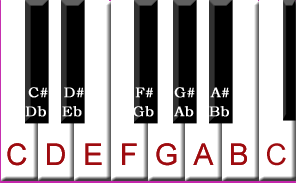I've received some questions about learning notes from the very new beginning students. Answering the questions actually turns out to be a bit of an effort.
Once you know the notes, it becomes second nature, and going back to the basic idea of notes to explain to the new student takes going back to being able to get to the real basic ideas. Here is a general explanation or overview of the note concept. I find it to be a bit basic, yet complicated to simplify the concept.
The Music Notes
The new student of music will need to learn notes to read music. The note is a symbol with a format that sets a definition of two basic pieces of information. Each note represents a tone or pitch and a time value.
The tone is what is played and the time value is rhythm for how long that tone is played. From this foundation various modifiers are applied to each of these components to allow for expression of tone or to adjust the time value.
With these two things defined you can learn to read the notes and reproduce a series of notes to play music. Combining notes in patterns extends the flavor and fullness of the sound.
The 12 Note Framework
 In the basic theory lessons we examined notes in half steps on the keyboard. Each key black and white key is a half step in tone when moving from one to the next. At the sixteenth half step the unison or first tone sound repeats at a higher pitch starting the tone relationships over.
In the basic theory lessons we examined notes in half steps on the keyboard. Each key black and white key is a half step in tone when moving from one to the next. At the sixteenth half step the unison or first tone sound repeats at a higher pitch starting the tone relationships over.
Note names
Every one of the keys has a note name associated with it. And as we learn from the sharps and flats, they have more than one name. Using the 7 letter names, A to G, the modifications of sharp and flat are applied.
The white keys of a piano get the seven names. Usually we start with the C key and label then in order up to G, go back to A and continue back to the 13th key which is C. This is known as the Scale of C Major. a mathematical representation of whole and half step tones. This scale represents the sounds that have a harmonic relationship.
Note Name Modifications
Each of these base notes may be modified up or down using a flat symbol (b) or sharp using the (#) symbol to decrease or increase the note a half step to modify its name using these symbols.
On the keyboard the black keys are the sharp and flat notes that represent the key note. Also be aware that the two white keys that are side by side can also be modified this way. The B key will take on the note name of C flat (Cb) and the C note can be a B sharp (B#). Similarly at the E and F notes.
Master Staff Used to Show Notes
Notes are identified by position and are notated on the master staff to show which note will be played. Yes you have to put in effort to learn the master staff, but it does not have to be as intimidating. Section 2 of the Getting It Down Cold Notes Workshop uses a fun and fast method to help you learn the full master staff..
Note Time Value
The second component of notes
 The key to defining note time value is the number 2. Each note has a value that is either divided by two or multiplied by two. The rhythm lessons at music theory rhythm goes through this principle and you can learn a tremendous amount by just by going through those lessons.
The key to defining note time value is the number 2. Each note has a value that is either divided by two or multiplied by two. The rhythm lessons at music theory rhythm goes through this principle and you can learn a tremendous amount by just by going through those lessons.
To truly understand the time value you will have to relate that to Time Signature which is also covered in the lessons.
Putting The Two Components Together
By defining tone/pitch and time value you now can read them on a staff and reproduce music that someone has written. In its simplest form the music will be a string of individual notes moving in pitch and simple time. In its most complicated form it will be a combination of tones moving in a complicated rhythm.
Music as a Language to Learn
Learning Notes seems simple at first until you release that even with just to components there is quite a lot of other information that has to be discussed to be able to fully understand and use them in reading and playing music.
Music is a language and is similar to the effort used to learn a spoken language. You learn letters which have vowels and consonants, learn to spell words, learn that words have functions such as nouns and verbs, learn that other words modify or enhance words, create sentences, and so on.
For the new student take your time get into the lessons, learn the parts, put it together. In time you'll learn and master this new language.
